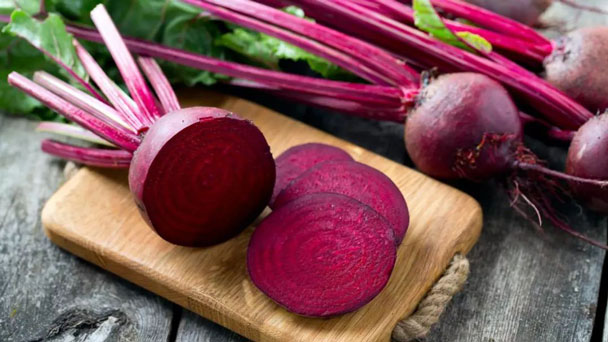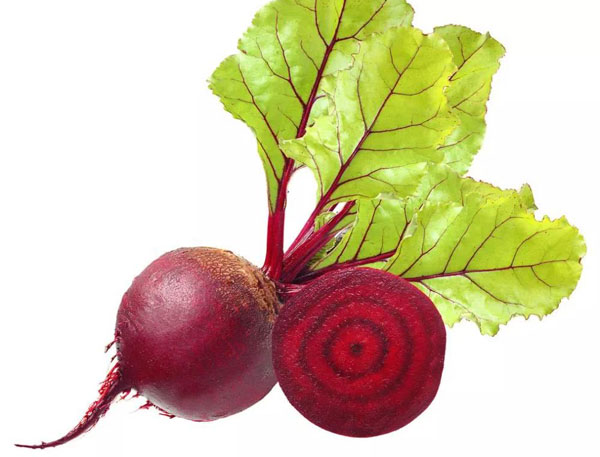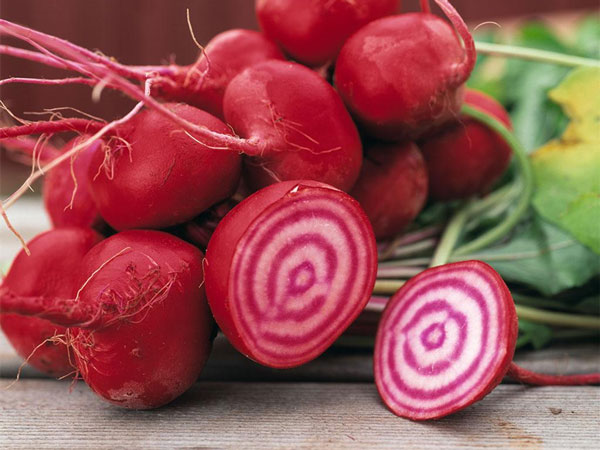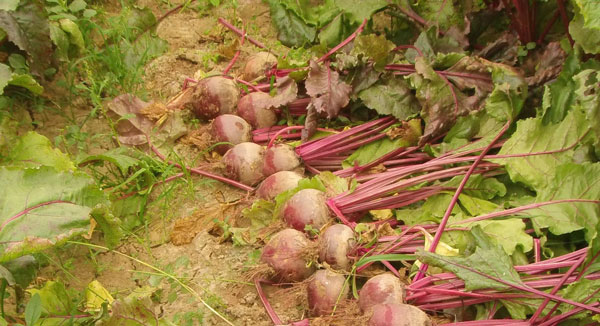Beets: Grow & Care for Beta vulgaris
Written by Iris
Nov 08 2021

Beets (Beta vulgaris) are great to eat fresh, baked, or canned. Both leaves and roots of Beets (Beta vulgaris) are edible. Beets (Beta vulgaris) is a typical kiwi vegetable that is easy to grow. Hardy, durable and not particularly fussy, Beets (Beta vulgaris) is ideal for both novice and experienced gardeners. Read our helpful guide on how to grow and care for Beets (Beta vulgaris).
Whether you're planting in pots or the garden, soil preparation is a must. Use a medium rich, well-drained soil that's been loosened with a garden fork. Mix in some compost and manure with a bit of blood and bone. Also add some boron, which is generally lacking in Australian soils. Mound the soil to improve drainage if necessary.
You can use our Garden Planner to work out exactly when to sow beets in your area. The software uses your location to set personalized sowing dates for your garden. Just click on the Plant List that accompanies your plan to find out exactly when you can expect to sow and harvest. If you add a season extender such as a hoop house or row cover to your beets, the dates in the Plant List will automatically adjust to take into account the additional warmth.
For an early beetroot crop, select a variety known for its resistance to bolting and sow under cloches from the beginning of March.
It’s worth ‘station sowing’ beetroot to ensure a good crop. This means sowing two seeds at each location and thinning later to one seedling – the thinned seedlings are delicious eaten raw in salads. Label the row, then water along its length.
Beetroot grows well in large containers of sifted garden soil or high-quality compost. It’s an attractive crop and perfect for an ornamental kitchen garden.
Temperature and Humidity
Beets are not quite as cold-tolerant as cool-season vegetables, like broccoli, but they can tolerate a light frost. They like cool temperatures, so beets are generally grown in the spring or fall.
Beetroot Rainbow Beet - a fun mixture of different colours to brighten up meal times.
Beetroot Ace F1 - large quality roots. F1 vigour makes this a good choice for poorer or drier soils.
Beetroot Detroit 2 Crimson Globe - an improved selection replacing the ever popular Detroit. Rich maroon roots with good flavour.
Beetroot Rubidus - for those that can't wait for the first crop of the season this is the choice for you. A week earlier to crop than Boltardy, with virtually no threat of bolting in cold snaps
Beetroot Moneta - the best option for the lazy gardener, no thinning required! Beetroot 'Moneta' will produce bumper crops of smooth, tasty roots, and hardly any will go to seed.
Beetroot Pablo F1 - a top quality RHS AGM variety producing smooth-skinned, round roots with a dark red skin.
Alto Beetroot Variety
Beetroot Alto F1 - the first F1 cylindrical beetroot, producing large long roots. A great space saver, allowing more plants per row.
Beetroot Boldor - an improved golden variety, producing sweet colourful roots for a wide range of uses - try it an unusual addition to stir fries. Better seed emergence than older golden varieties.
How to Choose and Prepare a Planting SiteWhen to Grow Beets (Beta vulgaris)How to Grow Beets (Beta vulgaris)Steps for Beets (Beta vulgaris) Propagation with SeedsHow to Care for Beets (Beta vulgaris)LightSoilWaterFertilizerHarvesting Beets (Beta vulgaris)Storing Beets (Beta vulgaris) over winterVarieties of Beets (Beta vulgaris)Beets (Beta vulgaris) FAQCan You Grow Beets in Containers?What is Companion Planting?
How to Choose and Prepare a Planting Site
Beetroot prefers cool to warm climates. It needs at least 4 hours of full sun a day and grows best at the base of larger plants like capsicum and tomatoes or anywhere you've just grown leafy greens like lettuce and spinach. A little bit of shade won't hurt either.Whether you're planting in pots or the garden, soil preparation is a must. Use a medium rich, well-drained soil that's been loosened with a garden fork. Mix in some compost and manure with a bit of blood and bone. Also add some boron, which is generally lacking in Australian soils. Mound the soil to improve drainage if necessary.

When to Grow Beets (Beta vulgaris)
Sow seeds outdoors from mid-spring until the middle of summer. You can sow a couple of weeks earlier by using crop protection – for instance, grow them in greenhouse or hoop house borders, or sow into trays or pots under cover to plant out once temperatures outside have improved. In areas with scorching summers you'll need to avoid growing them in the hottest months, but you may be able to squeeze in a fall crop.You can use our Garden Planner to work out exactly when to sow beets in your area. The software uses your location to set personalized sowing dates for your garden. Just click on the Plant List that accompanies your plan to find out exactly when you can expect to sow and harvest. If you add a season extender such as a hoop house or row cover to your beets, the dates in the Plant List will automatically adjust to take into account the additional warmth.

How to Grow Beets (Beta vulgaris)
Steps for Beets (Beta vulgaris) Propagation with Seeds
Sow beetroot seeds outdoors from mid-April to late June, into a shallow drill, 1cm deep. Space seeds 10cm apart, with 30cm between rows. Being a root crop, it does best if the soil is free of large stones, and prefers light to fairly heavy soil.For an early beetroot crop, select a variety known for its resistance to bolting and sow under cloches from the beginning of March.
It’s worth ‘station sowing’ beetroot to ensure a good crop. This means sowing two seeds at each location and thinning later to one seedling – the thinned seedlings are delicious eaten raw in salads. Label the row, then water along its length.
Beetroot grows well in large containers of sifted garden soil or high-quality compost. It’s an attractive crop and perfect for an ornamental kitchen garden.
How to Care for Beets (Beta vulgaris)
Light
Because beets are generally grown as a root crop, they will do best in full sun but should do fine in part shade. You can tuck beets in between taller plants in the garden.Soil
Prefers well-drained sandy loam to silt loam soil, high in organic matter, with pH between 6.5 and 7 and free of large stones. Good soil structure is important because growth is improved by good soil aeration. Beets grow poorly in acid soil. They tolerate low fertility but require consistent moisture. Do not plant in soils with pH less than 6.0. Beets use boron inefficiently. Boron is less available in soils with high pH and high organic matter. Corky black areas in the roots indicate boron deficiency.Water
Provide at least 1 inch of water every week. Mulching will help to keep the soil from drying out and getting too warm.Temperature and Humidity
Beets are not quite as cold-tolerant as cool-season vegetables, like broccoli, but they can tolerate a light frost. They like cool temperatures, so beets are generally grown in the spring or fall.
Fertilizer
Scatter 1 cup of a complete fertilizer such as 10-20-10 for each 10 feet of row. If the garden soil has a lot of clay, add compost. Mix the fertilizer 4 inches into the soil with a rake and work into beds as shown in Figure 2. Scatter 1 tablespoon of fertilizer for each 10 feet of row beside the plants when they are 4 to 6 inches tall.Harvesting Beets (Beta vulgaris)
Roots can be lifted at any time from June to October once they have reached a minimum 2.5cm (1") diameter - they aren't much use before then. As mentioned, plants can be grown on for around 12 weeks in order to pull fist sides roots for baking etc. Left much longer, the roots can turn coarse, so it is better to lift and store, than allow to keep growing. Roost should [pull easily from the soil by hand, on heavy soils a trowel may be needed, but be careful not to slice into the roots, reducing their straoge life. If surrounds roots are disturbed during lifting, simply firm back in and water.Storing Beets (Beta vulgaris) over winter
Beetroot is shallow rooting and should easily lift with a pull to the foliage. Soil can be loosened with a fork or trowel if needed. Remove the foliage to prevent the roots from bleeding their juice. Place roots in a box of compost and store in a cool, frost-free space. In warmer areas roots can be left in the ground over winter, covered with a 15cm deep layer of straw before frosts arrive.
Varieties of Beets (Beta vulgaris)
Beetroot Boltardy - a traditional variety with evenly deep coloured roots. Good resistance to bolting makes it ideal for an early sowing.Beetroot Rainbow Beet - a fun mixture of different colours to brighten up meal times.
Beetroot Ace F1 - large quality roots. F1 vigour makes this a good choice for poorer or drier soils.
Beetroot Detroit 2 Crimson Globe - an improved selection replacing the ever popular Detroit. Rich maroon roots with good flavour.
Beetroot Rubidus - for those that can't wait for the first crop of the season this is the choice for you. A week earlier to crop than Boltardy, with virtually no threat of bolting in cold snaps
Beetroot Moneta - the best option for the lazy gardener, no thinning required! Beetroot 'Moneta' will produce bumper crops of smooth, tasty roots, and hardly any will go to seed.
Beetroot Pablo F1 - a top quality RHS AGM variety producing smooth-skinned, round roots with a dark red skin.
Alto Beetroot Variety
Beetroot Alto F1 - the first F1 cylindrical beetroot, producing large long roots. A great space saver, allowing more plants per row.
Beetroot Boldor - an improved golden variety, producing sweet colourful roots for a wide range of uses - try it an unusual addition to stir fries. Better seed emergence than older golden varieties.

Beets (Beta vulgaris) FAQ
Can You Grow Beets in Containers?
Absolutely, growing beets in containers is possible. Almost anything that can be grown in the garden plot can be grown in a container, given the proper nutrients and growing conditions. Beets (Beta vulgaris) are cool season veggies that are delicious both for their tasty roots as well as for their nutrient packed leafy greens. With their sometimes bright green to variegated foliage, often with red stems and veining, beets are a colorful vegetable to grow on the patio or lanai and the care of potted beets is simple. Beets can be planted in the spring or fall, or both for a double crop.What is Companion Planting?
Beets add minerals to the soil. The greens are very good for the compost. Plant with bush beans, Brassicas, corn, garlic, kohlrabi, leeks, lettuce, and mint. Add cut mint leaves as a mulch for beets. Avoid planting beets near pole beans, as the nitrogen fixed by the beans may encourage leafy beet growth and diminished root development.Read Next:
15 Fall Vegetables to Plant for Your Autumn Garden
Latest Updated
- Benefits of Bugleweed - 7 Science-backed Health Benefits
- Bugleweed Dangers & Side Effects - Is It Poisonous?
- How to Plant Evergreen Trees - What You Should Know
- When to Plant Evergreens - Grow Guide for Evergreen Trees
- 12 Wonderful Evergreen Shrubs for Your Garden
- 12 Popular Evergreen Plants with Pictures for Beginners
- When And How To Prune A Lilac Bush Like a Pro
- How to Grow & Care for Lilac Vine (Hardenbergia Violacea)
- Japanese Lilac Tree (Syringa Reticulata) Care & Propagation Guide
- Shumard Oak Pros and Cons - What to Know
Popular Articles
- Winter maintenance of Antirrhinum Majus
- How to Grow Terminalia Mantaly Tree
- How to Grow and Care for Crossostephium Chinense
- How to grow Antirrhinum Majus in spring
- Peristeria Elata (Dove Orchid) Profile: Info & Care Guide
- Underwatered Snake Plant (Sansevieria Trifasciata) - Signs And How To Fix
- How to Care for Brazilian Jasmine Plant (Mandevilla Sanderi)
- How to Grow & Care for Graptopetalum Purple Delight in Summer
- Rosa Chinensis (China Rose): Plant Growing & Care Tips
- How to Care for Baby Sun Rose (Aptenia Cordifolia)